There are a lot of critters homeowners fear, but one of the most infamous is the termite. These tiny pests are often mistaken for ants despite actually being related to roaches. Even more importantly, there are three types of termite to be aware of, two of which are known to infest homes.
Dampwood termites seek out damp wood and are usually a sign that there’s pre-existing water damage to your home. Drywood termites will attack dry wood, often making their way into homes in search of warmth. The third, subterranean termites, are less likely to cause problems but have been known to cause damage to structures from beneath.
There are a few ways to tell if these pests have invaded your home, such as discarded termite wings on your window sills. However, the most important one is their frass. Of course, spotting what looks like termite poop can lead to confusion if you don’t see other clear signs of a termite infestation.
This might be a case of mistaken identity, so let’s look at what termite droppings are, what they aren’t, and what to do if you verify their presence.
The Scoop on Termite Poop
Termites don’t actually eat wood. Instead, they consume the cellulose found within wood. This substance acts like a glue to hold the wood fibers together. As a result, the frass itself is often mistaken for sawdust due to its high wood content.
What Does Termite Poop Look Like?
The species of termite affects what their frass will look like. Luckily, the difference is easily noticeable.
Drywood Termite Droppings
At first, drywood termite frass look like piles of sawdust, but it’s easily distinguished on closer inspection. The pellets tend to be tiny and oval, sometimes with an almost hexagonal shape.
Their coloration may vary depending on the type of wood the termites are eating, and it’s not unusual for there to be multiple shades if more than one kind of wood has been attacked.
Dampwood Termite Droppings
However, if you’re dealing with dampwood termites, the poop is much different than the tidier drywood termite pellets.
In this case, the termites initially create hardened waste, but the moisture within the wood will cause their frass to break apart, turning into a gooey paste. The more moisture present in the wood, the messier the droppings will become.
Subterranean Termite Droppings
“But wait!” you say, “didn’t you say there was a third kind of termite? What does their frass look like?”
Funny you should ask that. But seriously, these critters live underground and leave their nests to forage, which may include chewing on your home. While other termites leave behind visible droppings, subterranean termites are a lot like toddlers.
When they poop, it’s runny and they will spear it all over their tunnel walls to harden like mortar (any parent reading this is no doubt very aware of such behavior). Because of this practice, you will likely never discover subterranean termites through their frass.
See Also: 9 Bugs That Look Like Termites
Where is Termite Frass Typically Found?
Termites are fairly clean critters and have adapted a toilet system not too different from one humans have used in past on ships and in castles. This involves cutting a small hole in the wall (for castles and ships, the hole was in a little extended portion so poop would fall outside) known as a kick hole.
The termites shove their poop out of these little kick-out holes so it accumulates in your living space rather than theirs. This is a key factor in identifying if you have termites or a different wood-invader such as carpenter ants. If you see frass along the baseboards and there are tiny holes in the wall above them, it’s a sure sign of termite activity.
Does the Frass Smell?
This can vary slightly, although termite poop usually has a musty or moldy smell. This isn’t always the case, however, so it’s best not to rely on this as the only factor in determining whether or not the poop belongs to termites. Instead, focus on spotting any exit holes in wood or drywall above the frass.
Are Termite Droppings a Potential Health Hazard?
Unfortunately, the presence of droppings is both a direct and indirect health risk for people and pets. Indirectly, termite activity can lead to mold and mildew, which can lead to respiratory illness in even healthy people.
The presence of termite nests also mean there’s probably structural damage to your home. This can lead to a risk of collapse, electrical fires, or other potentially life-threatening situations.
More directly, the frass can cause allergic reactions in people, as well as set off asthma attacks.
What Does It Mean If You Find Termite Poop But No Termites?
As mentioned, termites get rid of their excrement through tiny openings, known as “kick holes” or “kick-out holes”. These openings are too small for the termites themselves, meaning you could easily see the frass with no other signs of termite activity.
Any time you spot termite frass, you can be sure termites are nearby, and if you can find the kick hole, you’ll know where at least part of the nest is.
Read Also: Can You Use Gasoline to Kill Termites?
Termite Droppings vs Something Else
So what happens if you see what looks like frass but have no kick holes or other signs of an infestation? It’s very possible the droppings are from a totally different critter, so let’s go over a few common ones and how to tell the poop apart.
Ant Droppings
Ants are common household pest capable of leaving frass similar to dry wood termites. Most ant poop is small and black, but carpenter ants are a bit different, having poop that looks a lot more like that of termites.
The easiest way to tell the two apart is to grab a magnifying glass. Carpenter ant waste is bulkier than that of termites. You’ll also see bits of dead ants in the frass, as carpenter ants will eat other ants as a source of protein. They generally leave their feces laying around outside nest entrances.
Roach Droppings
Cockroaches have different types of poop depending on their size. The smaller ones have small dark ball poop that is often described as resembling ground pepper or coffee grounds. Meanwhile, larger roaches have a more elongated pellet poop. The larger frass can be distinguished from other pests by the flattened ends and ridges down their length.
In most cases, roach droppings are a very dark, almost black color, which sets it apart from what you might expect of termite frass. However, some darker woods can lead to termite excrement also being nearly black – leading to some people also comparing termite frass to coffee grounds and light wood-based frass resembling piles of salt.
Sawdust
From a distance, sawdust can look a lot like drywood termite pellets. However, closer inspection will reveal the shape is totally wrong. Instead of pellets, sawdust looks like very tiny wood shavings, flat and often curled slightly.
Spotting sawdust at the bottom of a wall is still cause for concern, as it could indicate other wood-loving pests are attacking your home.
For example, the carpenter bee isn’t quite as scary as a dampwood or drywood termite infestation, but they can still do some damage to your home. These bees will use their mouths to carve away bits of wood, which they then discard outside the hole.
Because they aren’t actually eating the wood, the resulting material is literally just sawdust.
Wood Borer Beetle Droppings
There are three major types of wood borer that have a reputation for damaging wood, each with their own unique frass:
- Deathwatch beetles have a semi-coarse frass.
- False Powderpost beetles have very coarse frass.
- Powderpost beetles have a soft, powdery frass.
These are all fairly distinct from termites, but can sometimes be confused from a distance.
What to Do if You Find Termite Droppings
There are two rules of thought as to dealing with termite droppings. Let’s begin by looking at those methods, then examine one last common question that could have serious consequences.
When to Leave the Frass
Your first instinct might be to get rid of the droppings when you find them. However, consider leaving them in place for the moment.
Contact an exterminator to have them come and examine the feces. Not only can they confirm if you have an active infestation, they’ll have an idea of where the nest is and may also be able to determine its size by the number of kick holes found in the walls.
Another thing to keep in mind is that a pest control professional will remove the frass during their inspection, so leaving the piles until you’ve consulted with an exterminator won’t hurt anything. In fact, it might make the inspection more fruitful, saving you some money in the long run.
When to Remove the Frass
But let’s say you or a loved one has an allergy or need to remove the debris for some other reason. If you haven’t already verified that it’s a result of termite damage, use a glove or other tool to carefully collect some of the suspected frass into a plastic bag.
You will want to take this to a pest control expert for verification. Be sure to also take pictures of the places where you found frass so the exterminator knows where to look.
At this point, you can use a broom or vacuum cleaner to remove the debris. Try to avoid any direct contact and sanitize the area afterwards. Again, this is NOT recommended if you are able to wait for a professional, but we also understand there are times when waiting might pose a health risk.
What if the Frass Is Old?
Sadly, the exact same rules apply. Frass is made out of wood pulp, so it won’t discolor with age. This means you likely won’t be able to tell how fresh the poop pile is. And even if you have reason to believe it’s been there for a while, termites don’t simply go away.
In fact, a termite infestation can continue for years after the initial infestation has occurred and it’s extremely rare for a termite colony to completely die out of its own accord. The only exception to this tends to be disease, which is far more likely to reduce a colony than wipe it out. But there is one possible exception to the rule.
Sometimes the methods used to eliminate various termites species involve slow poisons. This means the termites might continue producing fecal matter for a short time after the treatment.
Cleaning is Part of the Treatment Plan
Any good pest control company will clear up the frass during their final inspection, as any new fecal pellets or smears would alert the homeowner that a new colony has arisen or there were survivors of the previous extermination attempt.
Keep in mind, exterminators tend to be very thorough (that’s what you pay them for, after all), but there are rare occasions when they might miss a pile hidden behind a refrigerator or other heavy object.
Even if you suspect this is the case, it’s best to phone the exterminator for a followup – which should be covered in your contract. Any reputable company will first check the area to make sure they didn’t simply miss a spot, then ensure it’s properly cleaned one they’ve verified there’s no new infestation.
And if the infestation has returned, they’ll usually treat your home under any warranty terms you agreed to. Finally, there’s always a chance they’ll find this “forgotten” frass pile is from a different pest infestation altogether and be able to address it.
- How to Get Rid of Hawks - March 8, 2024
- How to Get Rid of Pill Bugs (Rolly Pollies) - March 1, 2024
- How to Get Rid of Groundhogs (Woodchucks) - February 5, 2024

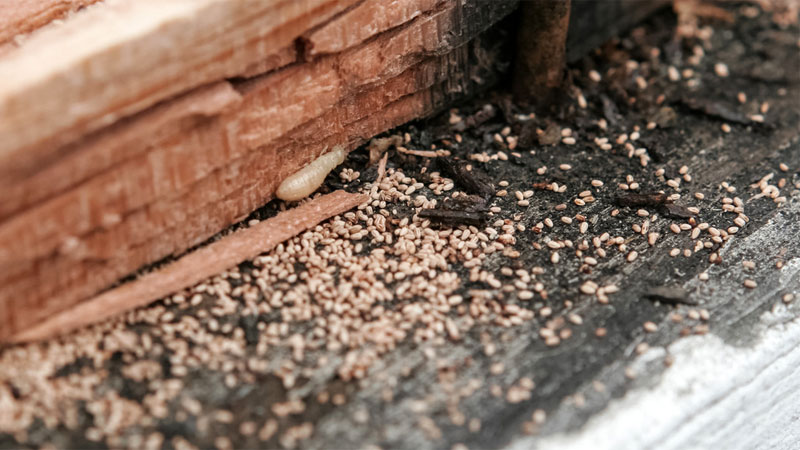
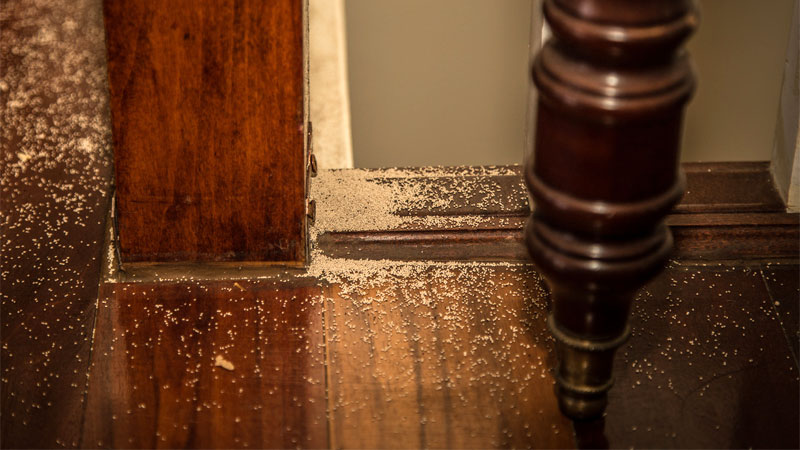
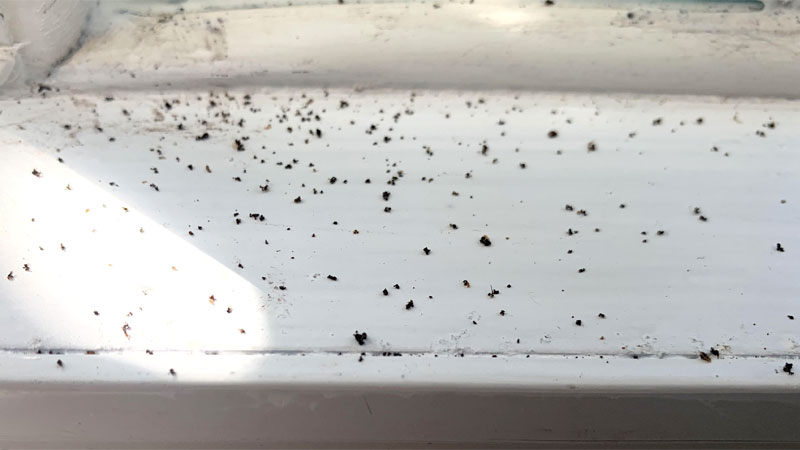
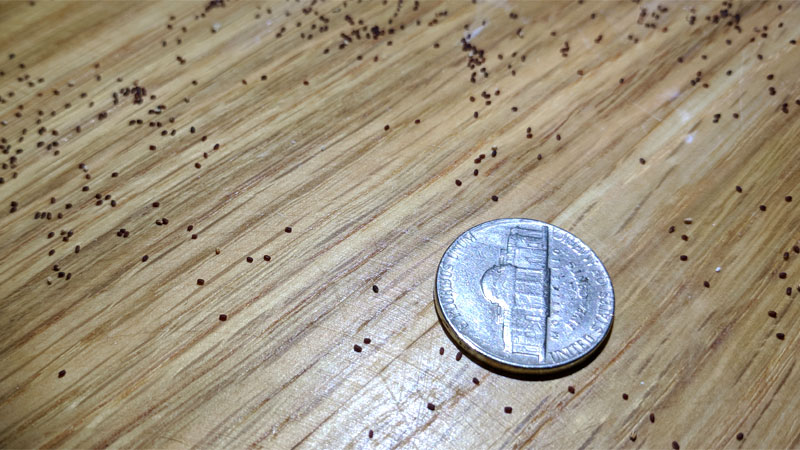
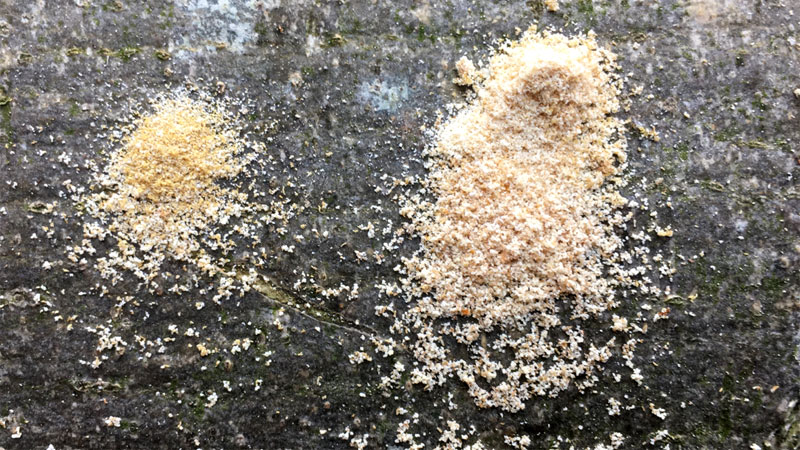
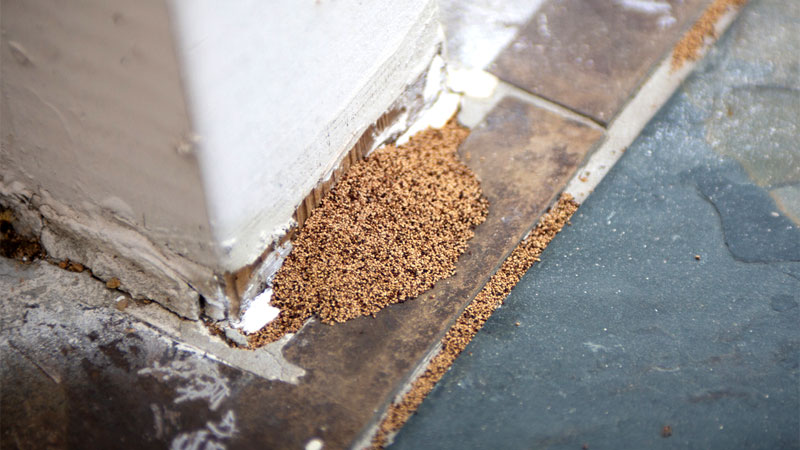
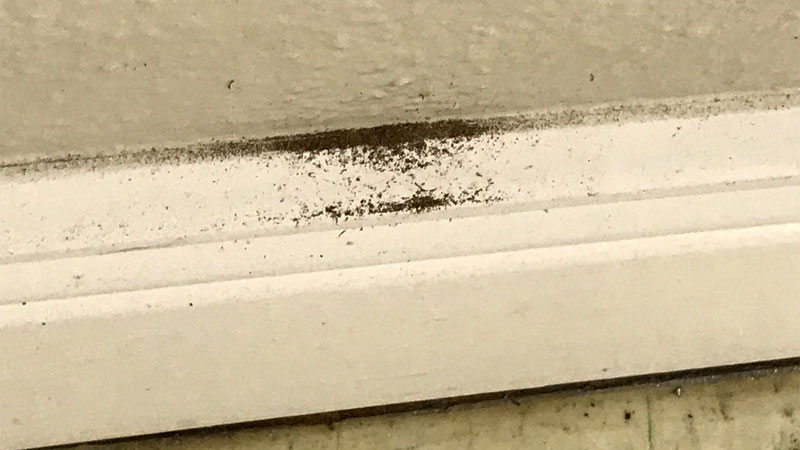
I am finding frass on the floor but can detect no push out hole. Is that possible?
Even if you don’t see a pushout hole, it’s possible that the hole is hidden or that the droppings have been pushed out from an area that isn’t easily visible. Termites can create VERY small holes. It’s also possible that the frass has fallen from an overhead location, or that it has been carried from another area by the termites themselves. Without seeing the frass, it may also be carpenter ants but their frass is typically coarser and may contain insect body parts.